Pilot aircraft Lockheed XFV-1 (USA)
Several new experimental projects appeared in the post-war period due to the analysis of the experience of the Second World War and the development of ideas already tested in practice. Significant contribution to the victory over Japan was made by deck aircraft. Fighters and bombers carried by aircraft carrier ships successfully accomplished missions in various parts of the Pacific. In particular, deck fighters proved to be a very effective means of protecting ship formations from air attacks. It was obvious that deck aircraft should be developed in the future. In addition, there were some original proposals related to the sharp increase in its combat potential.
With all its advantages, deck bombers and fighters had a serious disadvantage - they needed specialized aircraft carriers. Operation of a full-fledged combat aircraft on ships and vessels of other classes was completely excluded. In this regard, there was a proposal to create a new aircraft, having sufficient combat characteristics, but at the same time capable of being based on decks of small size. Such aircraft could protect ship connections or transport ships.
In 1948, the United States Naval Forces Command launched a new research and development program, the purpose of which was to create a promising deck-mounted aircraft. It was necessary to develop a machine with the characteristics of a fighter aircraft capable of taking off from a limited area on the deck. The overall appearance of the new technology was also determined. It was assumed that it will have a certain similarity with modern aircraft, but will differ from them in some characteristic features.
In accordance with new ideas, on the ground or on the deck the “plane” was to be placed vertically, raising the propeller nose to the sky. At the same time he had to literally stand (or sit) on the tail. For this feature, promising technology was nicknamed Tailsitter - "Sitting on the tail." Subsequently, the unofficial nickname became the generally accepted term and full name of a separate class of aircraft.
Lockheed and Convair were involved in the new program, having extensive experience in the aviation industry, including deck. In addition, these companies could cope with the complex tasks of creating a completely new class of equipment. Initially, it was assumed that the two companies would create their own “tail sitter” projects, after which the military would choose the most successful one. This project will be developed, which will lead to the emergence of a contract for serial production and the start of operation of equipment fleet.
Such plans were relevant to the 1950 year, after which they were canceled. Seeing the current successes of the two aircraft manufacturers, the US Navy decided to reduce their needs and set new, more modest targets. Now it was proposed to develop, build and test two experimental aircraft. With their help, it was planned to check the main features of the unusual technology and establish its prospects. In the case of obtaining positive results, the Tailsitter program could be developed and lead to the appearance of a full-fledged combat vehicle.
Until the spring of 1951, Lockheed developed its “tailsitter” project using the working designation Model 081-40-01. 19 April The 1951 Navy ordered the construction of two prototypes. The corresponding contract introduced a new designation of technology - XFO-1. The letter “X” indicated the experimental nature of the project, the letter “F” indicated that the project implies the creation of a fighter. The last letter indicates the designation company. The figure, respectively, marked the number of the project in the line.
Soon after the signing of the contract, the United States Navy finalized the existing system of designation of aircraft. As part of such changes, Lockheed’s products were to receive the letter “V”. The designation of the pilot project, in turn, has changed - XFV-1. It is under this name that the aircraft became widely known in the future.
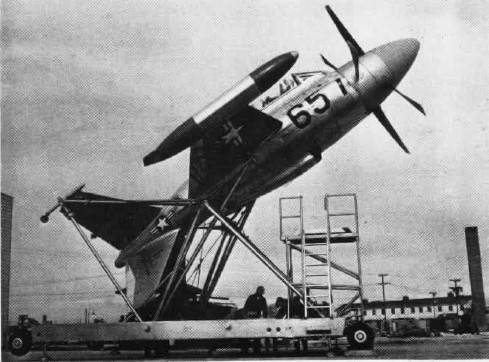
Rise in vertical position. Photo Airwar.ru
Even at the stage of preliminary theoretical tests, the overall appearance of a prospective aircraft was formed, which allowed to obtain the required results. "Tailsitter" proposed to build a normal aerodynamic configuration and equip the turboprop engine. At the same time, he needed tail plumage of a specific design, which was directly related to the proposed method of vertical take-off and landing. Other design features were determined in accordance with other customer requirements.
The XFV-1 aircraft tailster was proposed to be made an all-metal mid-plane. The main element of the car was the fuselage of a streamlined shape with a variable section. There was a large nose cone, behind which there was a coaxial screw hub. Directly behind the screws was the cockpit. Behind the cabin, directly above the bottom of the fuselage, was a turboprop engine. Behind him, the bottom had a concave shape necessary for removal of engine exhaust gases.
The aircraft received a trapezoid wing of a medium location. The entire rear edge of the wing was occupied by mechanization in the form of a large aileron. On the wing were installed cylindrical tips-containers of great length, equipped with fairings. The tips were completed with small additional planes in the rear.
Of particular interest is the tail of the experimental machine. On the tail of the fuselage were mounted four planes of the same design. The planes of the X-shaped tail had arrow-shaped leading and trailing edges. They were offered to install swinging aerodynamic steering wheels with trimmers. Control was to be carried out by synchronous or differential deviation of the rudders in different combinations. The ends of the stabilizer were equipped with power elements, on which it was proposed to mount small landing gear.
"Sitting on the tail" of the aircraft had to have an unusual chassis that can hold it in position. At the tips of the tail assembly were placed short racks with self-orienting wheels of small diameter and shock absorbers. This chassis allowed the aircraft to literally stand on the tail, and also gave acceptable maneuverability when moving on the ground. At the same time, independent movement and maneuvering on the ground was virtually excluded.
In the central part of the fuselage was placed Allison XT40-A-14 turboprop engine with 5100 horsepower. With the help of a set of shafts and a gearbox, the engine was connected with two coaxial screws of the Curtiss-Wright company. The aircraft received two three-bladed screws with a diameter of 4,88 m, rotated towards each other. On takeoff and landing, relatively large propellers were supposed to work as carriers, and in horizontal flight they performed the functions of pulling. To supply air to the engine, the Lockheed XFV-1 received a set of intake devices. Two air intakes of small width were placed on the sides of the fuselage, immediately behind the screw hub. The third was on the bottom of the fuselage at the level of the cockpit. Exhaust gases were removed through a nozzle under the tail boom.
Directly behind the screw hub placed a single cockpit. The pilot’s workplace had a traditional set of controls in the form of aircraft and engine control knobs and a pair of pedals. There were also dashboards with control devices and other controls. To improve the view of the aircraft received a large drop-shaped lantern. To improve the convenience of the pilot in different modes, an unusual chair was used with the possibility of changing its location over a wide range.
Already at the stage of development of the experimental project, the designers of Lockheed provided for the possibility of equipping the aircraft-tailster with one or another weapon. Weapon different types could be placed in containers at the ends of the wing. Their size allowed the aircraft to be armed with automatic guns or unguided rockets. For obvious reasons, at the design stage of the experimental aircraft, the composition of the weapons was not specified.
The total length (or parking height) of the XFV-1 aircraft reached 11,23 m. The wingspan is 8,36 m, the area is 22,85 sq.m. The empty machine weighed 5,26 T, the maximum take-off weight reached 7,36 T. According to the calculations of the designers, the tailster could carry out a vertical take-off, go to horizontal flight and reach speeds up to 930 km / h. Cruising speed was limited to 660 km / h. The ceiling was 13,1 km. The use of screws as carriers made it possible to obtain a climb rate at the level of 55 m / s.
The specific appearance of the aircraft made the project authors develop special means for its transportation. The Lockheed XFV-1 was transported by airfield using a special trolley with a set of fixings. Its main element was a platform with four small-diameter wheels. A holding device was hinged on the platform, with which the aircraft could be lowered into a horizontal position or raised into a vertical one. The pilot had to get into the cockpit with the help of stairs mounted on a trolley.
The development of the XFV-1 project was completed in the middle of the 1953 year, after which construction began on the first of the two required prototypes. The car brought to the test by the end of the year. The first ground tests showed that the finished machine, in general, meets the basic technical requirements, and also has no serious problems. Now you can start flight tests.
During ground tests, the aircraft received a new unofficial nickname - Salmon (literally “Salmon”). This name was not associated with the design features of the technique, but it still had a curious origin. Lockheed's chief pilot Herman Salmon, nicknamed “Fish,” was to test the prototype, and shortly after the checks began, the aircraft was named after the pilot. In addition, from a certain time the wits applied the nickname Pogo-stick (the Grasshopper) to the "Tailsitter", meaning the parallel project being developed by Convair XFY-1 Pogo.
Due to the lack of experience in the creation and testing of such equipment, the specialists of the company-developer did not dare to begin the tests with vertical takeoffs and landings. The first checks were to be carried out using the technique "on an aircraft". However, the design of the aircraft did not allow to do this, because of which there was a need for a new chassis. For runs on the runway, the experienced XFV-1 should have got an extra chassis. It was proposed to fasten V-shaped tubular main struts with large diameter wheels to the fuselage and center section. On the lower tail stabilizers were placed additional racks with small wheels.
In mid-March, 1954, Mr. Salmon had to run on the runway and check the parameters of the machine in this mode. During the jogging test pilot too much "gave gas", as a result of which the aircraft gained high speed and took off. In this unplanned flight, the aircraft managed to be raised to an altitude of 6 m. The maximum flight speed reached 287 km / h. Removing the gas, the pilot completed the landing. Despite the unexpected result, these trials were generally considered successful.
16 June 1954 of the year G. Salmon was the first to lift an experienced XFV-1 into the air. The existing engine was brought to the required speed, but its power was not enough for takeoff. The car remained on the ground, moving in different directions under the action of the steering wheels. Several attempts to take off did not succeed, which is why the test program was adjusted. It was proposed to finalize the project in order to obtain the required power supply, but this turned out to be impossible. It took several months to find a way out of this situation. Only at the beginning of the next 1955, the experienced “Salmon” once again managed to get on the runway.
In the course of subsequent test flights, it was found that the aircraft, during a normal takeoff, rises into the air at a speed of 220 km / h. The landing speed was only 130 km / h. On the 96 km / h, the prototype fell into a corkscrew, but a certain set of speed allowed to go into horizontal flight. The plumage of an unusual design, characterized by a large area, greatly simplified the exit from the corkscrew and ensured good stability in flight. The lack of engine power did not allow us to take off and land vertically, but this did not prevent the testers from testing the equipment in all modes of interest.
To test the plane-titsitter in a vertical flight, G. Salmon was raised to a sufficient height, after which he took the engine to maximum speed and made a “candle”. Similarly, the transition was made to horizontal flight. Such checks have shown that the existing 5100-strong engine does not allow not only to take off vertically, but also to maintain a given height. After moving to a vertical position, the aircraft almost immediately began to decline, gradually increasing the speed of descent.
By the middle of 1955, Herman Salmon more than 30 once raised an experimental XFV-1 machine into the air. The total flight duration exceeded 23 hours. During this time, all the necessary information was collected, which allowed us to determine the real prospects of the existing machine, as well as to form updated requirements for future representatives of an unusual class of aviation equipment.
The main drawback of the Lockheed XFV-1 Salmon "tailsitter" was considered to be an underpowered engine. The existing propeller group did not allow to take off and land vertically, because of which the project lost all meaning. At the same time, in practice, it was possible to confirm that an aircraft of unusual appearance, having a sufficiently powerful propulsion system, is fully capable of making a vertical take-off, go on to a horizontal flight, solve the set task, and then carry out a vertical landing. The use of a sufficiently powerful engine also made it possible to equip the aircraft with the required weapon system.
At the same time there were some other problems. So, with the vertical position of the fuselage, the view from the pilot’s workplace left much to be desired. Because of this, the pilot could have some difficulty observing the surrounding space and controlling the aircraft during separation and ascent to a safe altitude. It should be noted that such features and drawbacks of the machine could not be fully assessed during the tests due to insufficient engine performance and the impossibility of vertical take-off.
In the middle of 1955, it was decided to discontinue work on the XFV-1 project due to the lack of real prospects. It was suggested to wait until the adjacent enterprises could provide the engine with the required parameters, and only after that to continue the work. Soon there was a project with a working designation XFV-2. Such a tailsitter aircraft should have had some differences from the previous one. It was planned to equip it with a 54 horsepower Allison YT7100 turboprop engine. An improved aircraft could carry four 20-mm automatic cannons or two 40 units with unguided 70 mm caliber rockets. Nevertheless, the Allison company did not complete the development of the required engine, which is why the new project of Lockheed did not leave the stage of preliminary work.
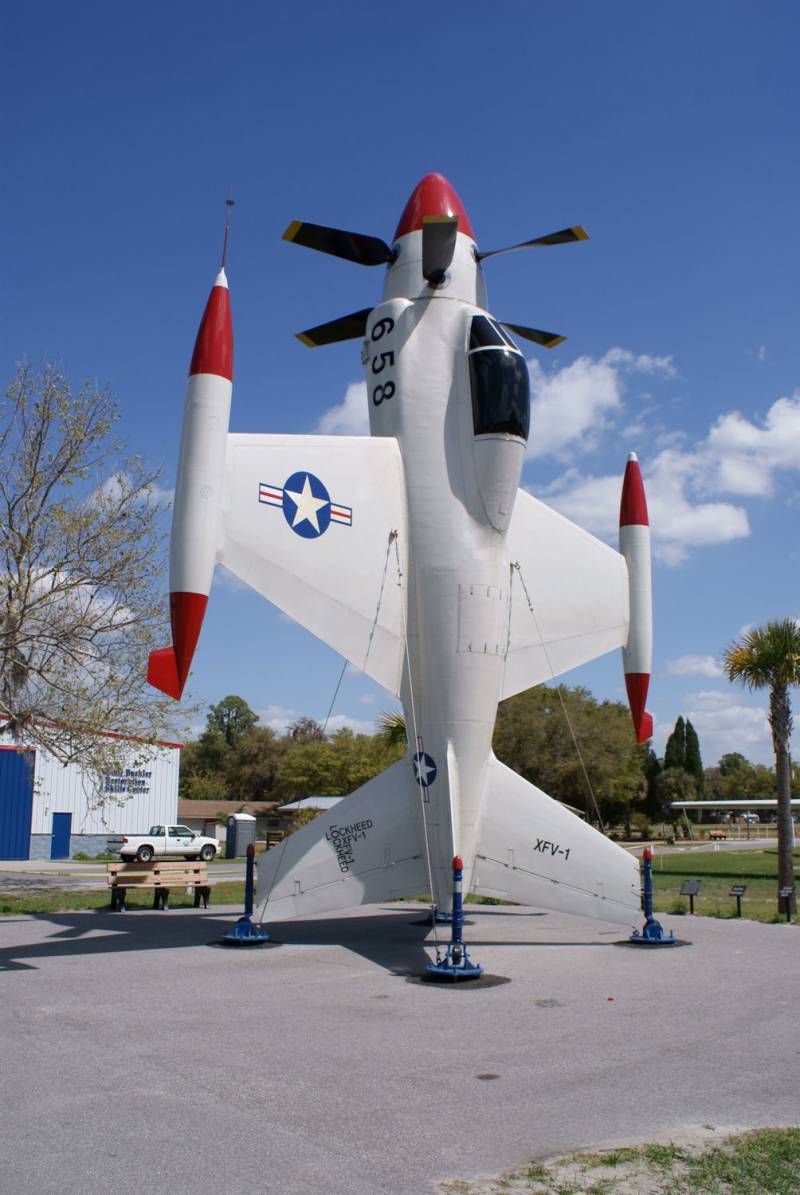
The first prototype of the Lockheed XFV-1 at the Sun 'n Fun Campus Museum. Photo of Wikimedia Commons
During the work on the project Lockheed XFV-1 was built two prototypes. The first car was used at all stages of the test, while the second never came out of the hangar. The absence of the possibility of conducting full-fledged flight checks in all modes did not allow testing both prototypes. After completing the tests and closing the project, the equipment was decided to be transferred to the museums. The only flying “tailsitter” went to the Sun 'n Fun Campus Museum (Lakeland, Florida). Previously, the car was shown in one of the halls of the museum. Later it was repaired, after which it was transferred to an open area and installed in a vertical take-off position. The second prototype is now at Los Alamitos airbase (California).
The Lockheed XFV-1 project was developed with the aim of practically testing original ideas in the field of vertical take-off and landing aircraft. Tests of the only flight prototype revealed the main advantages and disadvantages of this technique, which made it possible to determine the prospects for an unusual direction. At the same time, the Convair XFY-1 Pogo was developed and tested. During the checks, this car showed itself better and also made a significant contribution to the study of the subject "sitting on the tail."
On the materials of the sites:
https://vertipedia.vtol.org/
http://airwar.ru/
http://military-history.org/
http://aviastar.org/
http://aviadejavu.ru/
http://defensemedianetwork.com/
http://diseno-art.com/
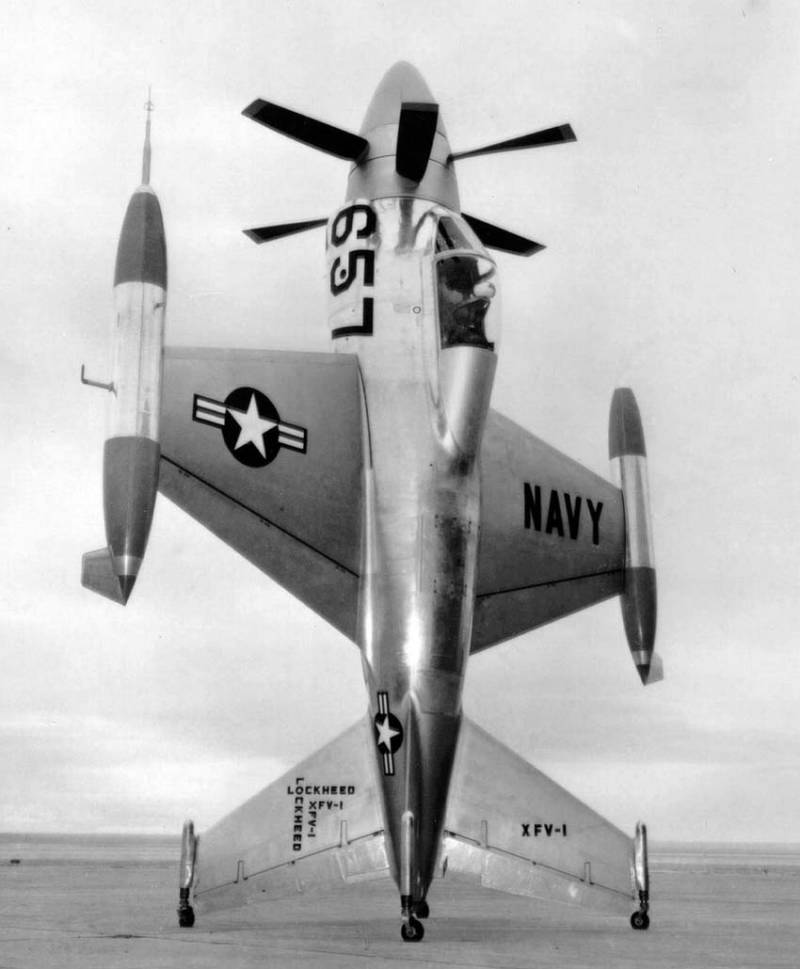
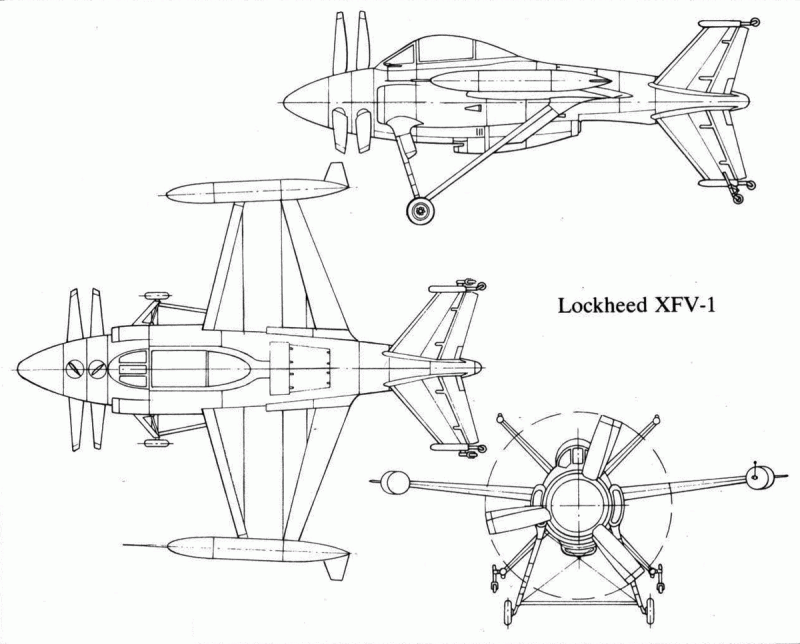
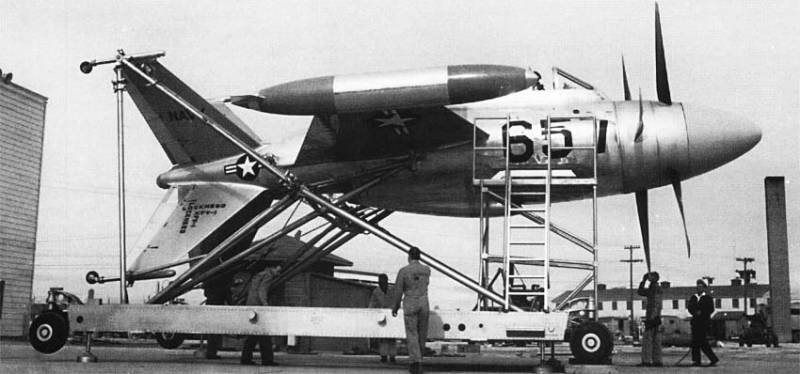
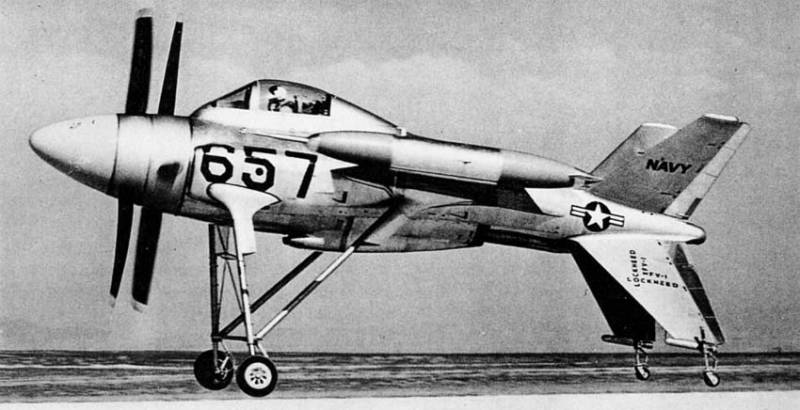
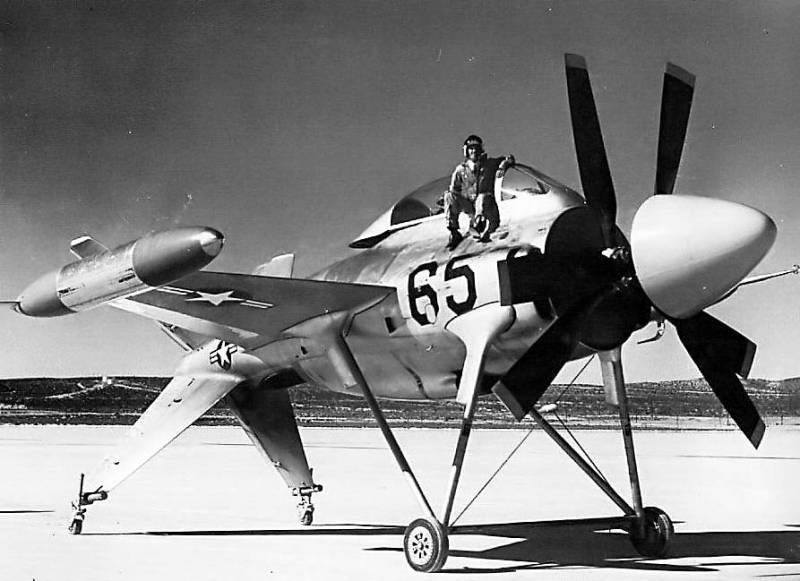
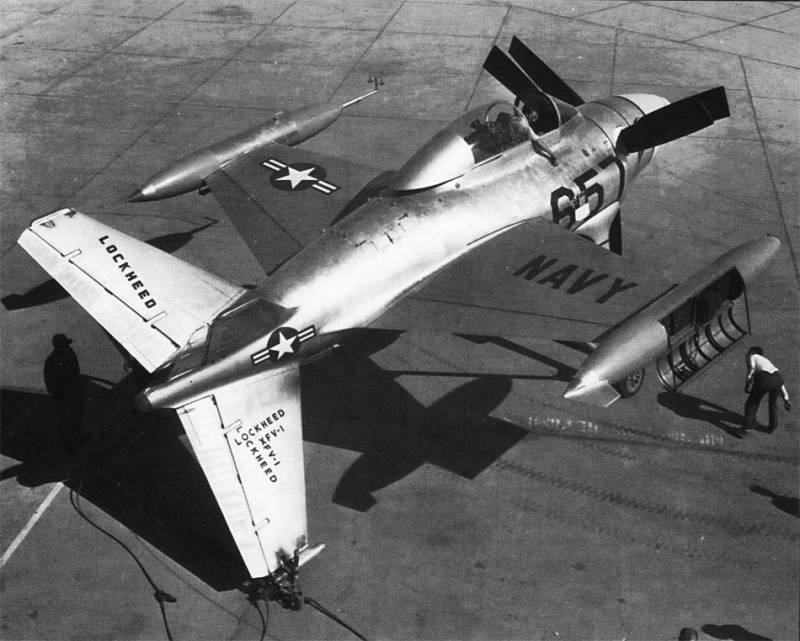
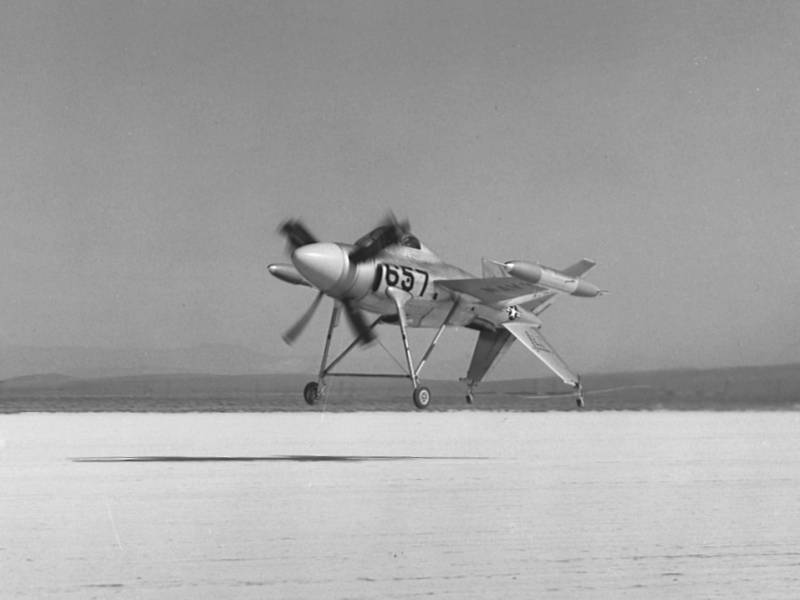
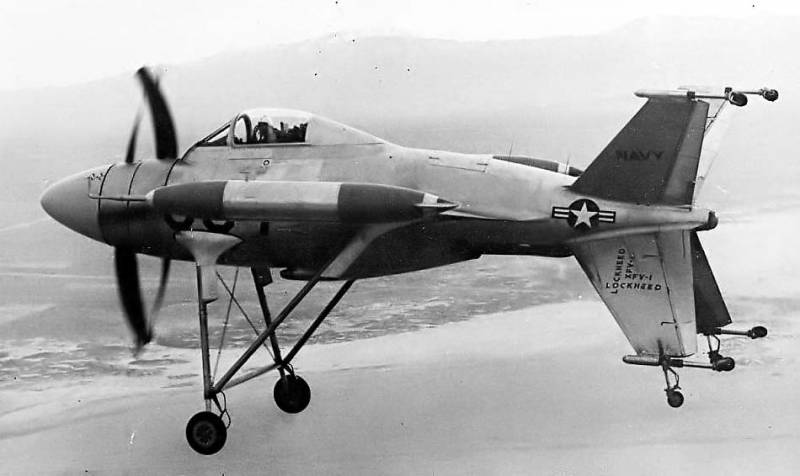
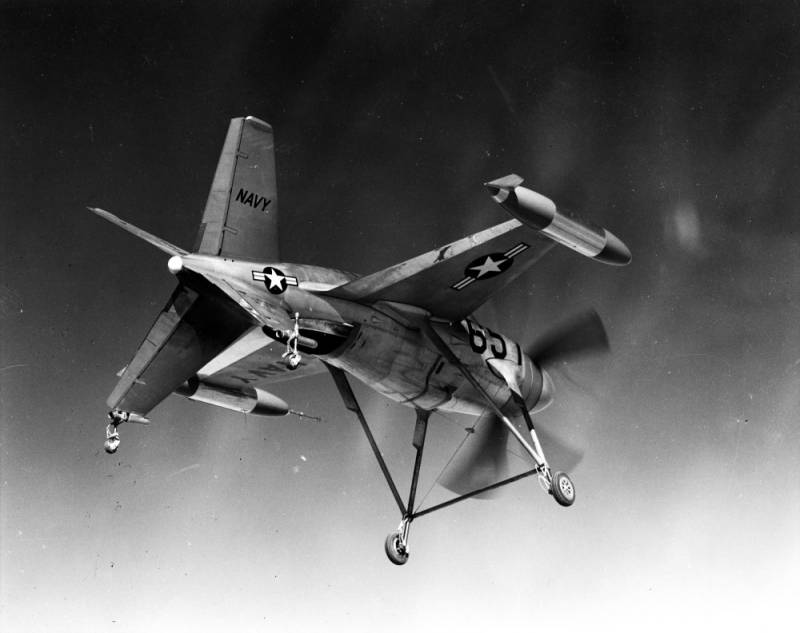
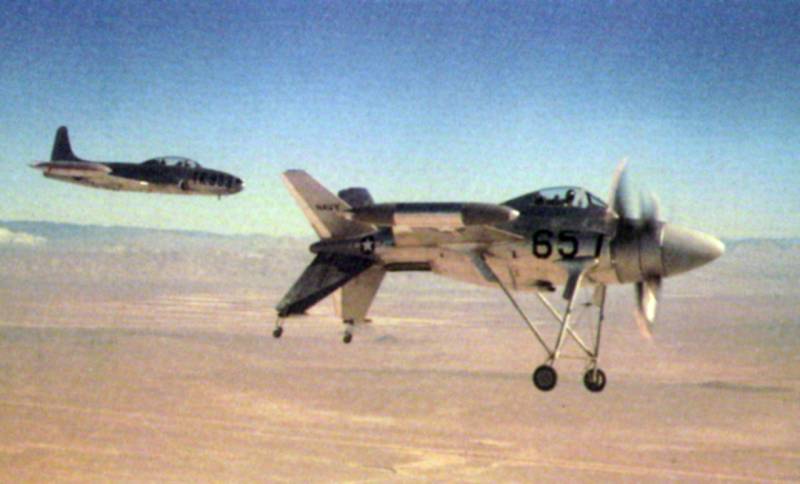
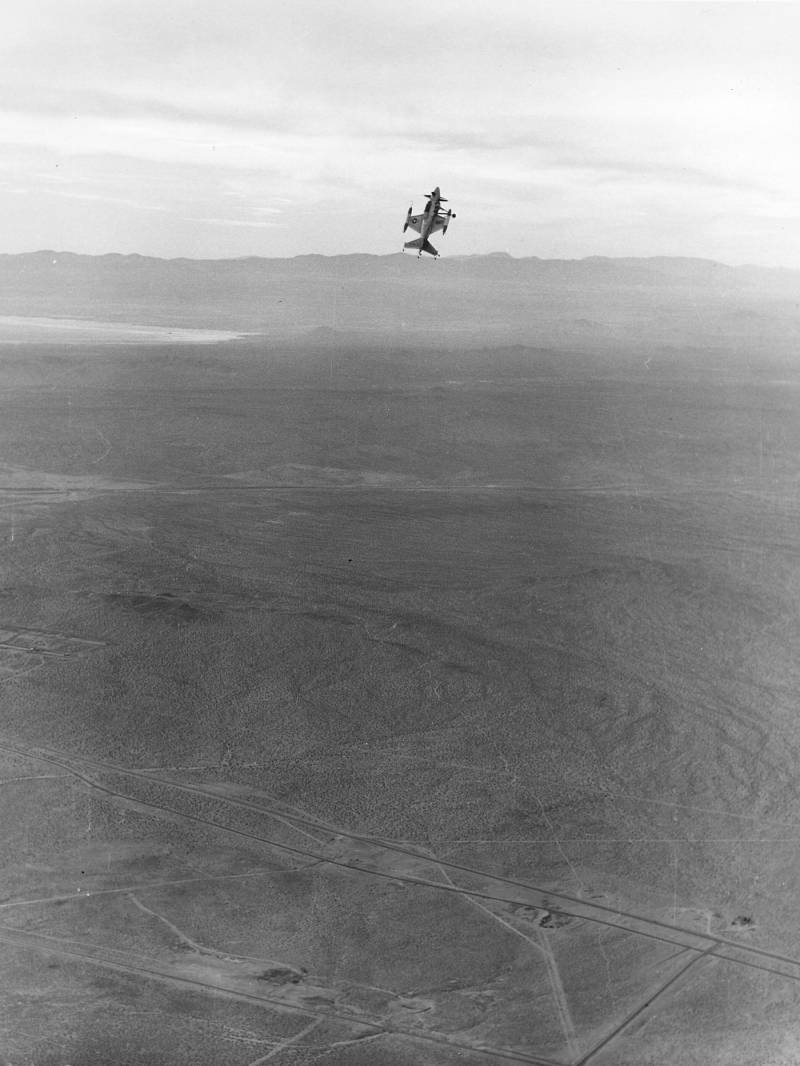
Information